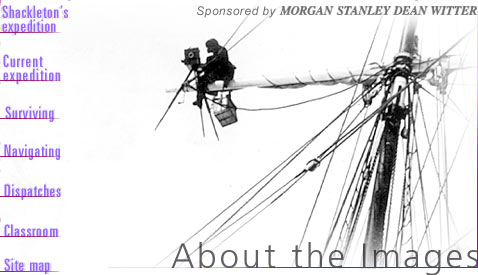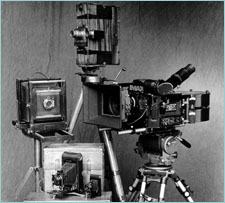 |
 |

The black-and-white images you'll find on this site were all shot by Frank Hurley, official photographer of the Endurance expedition. We have not modified them in any way, except, in a few cases, cropping or shading them to enhance navigation of the site. These stunning images come from albums of prints held at the Scott Polar Research Institute at Cambridge University and at the Macklin Collection. That they exist at all is a tribute to Hurley's care, skill, and dogged determination. First Officer Lionel Greenstreet called Hurley a "warrior with his camera [who] would go anywhere or do anything to get a picture." That included lugging his heavy "cinematograph machine," or early movie camera, up into the ship's topgallant yards to get a panorama of the ice pack (see photo above). Or developing his pictures in the Endurance's darkroom when the temperature outside was -55°F. Or chopping through a wood wall and diving beneath four feet of slushy ice to retrieve his glass-plate negatives from the sinking ship.
Hurley also selected 120 glass-plate negatives to save, including both whole (6-3/4" x 8-1/2") and half (4-3/4" x 6-1/2") plates. In an act that must have deeply pained this consummate professional, he smashed the remainder - about 400 negatives - and left the shards on the ice. He took the 120 glass plates and the already developed still and movie film and sealed them into a tin can, which he soldered shut and managed to keep safe all the way back to civilization. Some of the photographs and film footage ended up in Hurley's 1919 film South, but many of his striking stills would not be published until 1998, when Knopf published The Endurance: Shackleton's Legendary Antarctic Expedition, by Caroline Alexander. We have also made use of some of Hurley's film footage in Voyage of Endurance. Photos: (1) Frank Hurley; (2) Reed Smoot ©1999 WGBH. NOVA's Expeditions (1999 & 2000) | Shackleton's Expedition (1914) Surviving Antarctica | Navigating the High Seas | Dispatches Mail | Resources | Classroom Resources | Site Map | Shackleton Home Editor's Picks | Previous Sites | Join Us/E-mail | TV/Web Schedule | About NOVA Watch NOVAs online | Teachers | Site Map | Shop | Search | To Print PBS Online | NOVA Online | WGBH © | Updated February 2002 |
 Early and late-model cameras: Counterclockwise from top,
a reproduction 35mm Prestwich motion picture camera (circa 1908) and a Kodak square bellow field camera for
large-format plates, both similar to cameras Frank Hurley used; a Kodak Folding Pocket Camera Model 3A and a
Vest Pocket Kodak, both the very models Hurley took to Antarctica; and a modern IMAX camera.
Early and late-model cameras: Counterclockwise from top,
a reproduction 35mm Prestwich motion picture camera (circa 1908) and a Kodak square bellow field camera for
large-format plates, both similar to cameras Frank Hurley used; a Kodak Folding Pocket Camera Model 3A and a
Vest Pocket Kodak, both the very models Hurley took to Antarctica; and a modern IMAX camera.